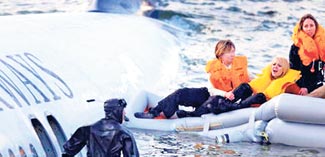Passengers on a recent flight from Bangalore that was about to touch down at Bandaranaike International Airport were suddenly told that there would be a slight delay – on account of birds. The reverberations that accompany the lowering of the wheels on the aircraft underbelly were already being felt by the passengers when they heard the announcement:
“Ladies and gentlemen, Air Traffic Control has asked us to hold back while the runway is cleared of a bird strike,” the pilot said on the intercom. The Airbus A 330 then gained altitude and completed a couple of circuits around Katunayake before returning to touch down.
 |
| On January 15, 2009, a US Airways plane was forced to make an emergency landing in the Hudson River in New York when a flock of birds got sucked into its engines. There were 155 passengers on board, and all escaped without injury. Pic courtesy Reuters |
Bird strikes have become a worry for the airport authorities, who have been compelled to set up a Bird Control Unit at the airport. One of the advisers for the unit is senior ornithologist Professor Sarath Kotagama, who heads the Department of Zoology, at the University of Colombo. Prof. Kotagama has been asked to conduct a study of the bird population around the BIA and make recommendations for handling bird strikes.
A bird strike – also known as a birdstrike, bird hit, or Bash (bird aircraft strike hazard) – refers to a collision between an airborne animal, usually a bird or a bat, and an aircraft. Bird strikes can threaten flight safety, and have caused accidents with human casualties.
Profuse bird breeding in the Negombo lagoon, adjoining the Bandaranaike International Airport, has resulted in a proliferation of birds in the vicinity of the airport.
Indigenous birds that pose a threat to aircraft are lapwings (kirala), egrets (especially cattle egrets), purple herrings, crows, mynahs and pigeons.
“We are seeing an increase in the local bird population, especially cattle egrets, across the country,” Prof. Kotagama told the Sunday Times. “A lack of a proper waste management system could be one of the reasons. Bird strikes can happen any time of the year. There is the danger of birds hitting the front of a plane or getting sucked into the engine.”
Prof. Kotagama said special measures are required be prevent bird strikes when aircraft are landing or departing. Birds can cause damage to engine or cockpit of an aircraft, enforce emergency landings, and even cause air crashes.
The airport infrastructure also requires protection against birds, the bird expert says. “Building structures in and around the Bandaranaike International Airport should be bird proofed,” he said. “The buildings should not attract birds looking to build nests.
“Bird strikes can happen any time of the year. There is the danger of birds hitting the front of a plane or getting sucked into the engine.”
– Prof. Sarath Kotagama, Department of Zoology head, University
of Colombo |
The cargo areas should be covered with nets and mesh. Once birds are drawn to a building, it is very hard to get rid of them. About five or six years ago, a large number of pigeons were removed from here and dumped in Wariyapola, but most of the birds have come back.”
According to Prof. Kotagama, airports tend to attract birds with their greenery, the lighting, and the general infrastructure.
“Migrant birds are especially drawn to the illumination provided at airports. The migrant bird menace is especially marked in the April-May and August-to-November periods. Migrant birds usually come in flocks.”
Rosy starlings, golden plovers, curlews, pipers, little-ringed plovers, crakes and turns are some of the migrant birds that visit Sri Lanka.
The hours of maximum danger from birds are in the morning.
“The time we need to be most vigilant is between 5 a.m. and 7 a.m. A large number of flights are scheduled in the mornings.”
Prof. Kotagama said thinning down the surrounding trees was one way of discouraging birds from nesting in the airport environs.
“When there was a thinning of lihinia trees around the airport, we noticed the birds starting to move away from the area. To check the bird threat, you have to eliminate or block spaces or shelters that are potential bird nesting areas.”
The airport management team head H. S. Hettiarachchi says safety measures prescribed by the International Civil Aviation Organisation are in place at the BIA, which is one of the airports with a bird strike control programme.
“We take the bird hazard seriously, and we have taken a number of safety measures. The important thing is discourage birds from coming to the aerodrome. All airport buildings, especially warehouses, should be built and maintained in a way that discourages birds.”
Bird control in Sri Lanka aims at distracting and repelling birds, rather than destroying them, Mr. Hettiarachchi said. Bird control officers work round the clock, seven days a week, he added.
One BIA bird control officer told the Sunday Times that bird carcasses have been found inside aircraft and on the ground. “We found five vulture carcasses in planes coming from India, and also carcasses of small migrant birds. We also had a couple of cases of flight engine damage, including damage to an Air Force Kafir jet.”
The Bird Control Unit uses sound systems, shotguns and firecrackers to frighten away birds, and light beacons to divert birds away from the airport.
According to Prof. Kotagama, birds are also a big financial risk for airports and airlines. “Most insurance schemes do not cover bird strikes,” he said. |


